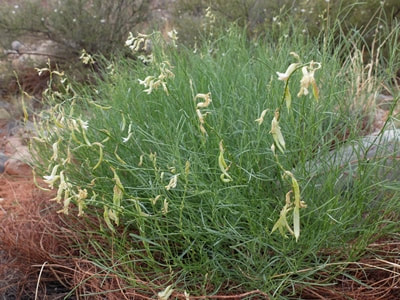|
Found in dry openings in piñon-juniper forests and open canyons
Seen blooming in April in Red Wash Canyon Another Milkvetch but quite different in appearance from the Missouri Milkvetch of a couple of weeks ago. Rushy Milkvetch grows like a bush to 2 feet wide and high with bright green stems and long, narrow leaves. Flowers are white and about an inch long and grow loosely clustered along the stem producing many spear-shaped 1" long seed pods. Both Missouri Milkvetch and Rushy Milkvetch contain swainsonine which is toxic to livestock and causes a wide variety of toxicological problems, including neurological, cardiovascular, and reproductive effects. For this reason, they should be more correctly called Locoweeds. “Loco” in Spanish means “crazy” and alludes to the often disoriented behavior of animals afflicted by these plants. Traditionally, the Navajo used it to induce vomiting and a poultice of the plant was applied to a goiter. Source. If you trying to identify a different flower then you can check what other flower bloom this month. If you cannot identify a flower from the website send a photo and where you took it to [email protected]. Read online for tips.
0 Comments
Leave a Reply. |
AuthorI am Marilyn Phillips, a native of England, whose love of nature and the outdoors from childhood brought me by a circuitous route to Crested Butte, Colorado in 1993 and 16 years later to northern New Mexico. My exploration of the many trails in these areas, my interest in wildflowers and photography, and career in computer system design came together in this creation. If you have any corrections, comments or questions, please contact me by email. Archives
September 2025
Categoriescopyright © 2020
|



 RSS Feed
RSS Feed